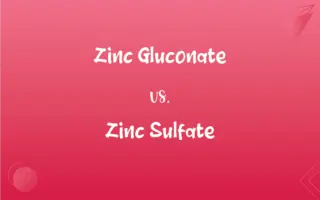Phosphoryl Group vs. Phosphate Group: What's the Difference?
Edited by Janet White || By Harlon Moss || Published on December 30, 2023
A phosphoryl group is a trivalent group derived from phosphoric acid, while a phosphate group is a tetra-valent ion of phosphorus, oxygen, and hydrogen.

Key Differences
The phosphoryl group, represented as PO_3, is a functional group derived from phosphoric acid by the loss of one or two hydroxyl groups. In contrast, the phosphate group is a broader term often used to describe phosphoric acid derivatives, typically the PO_4^3- ion.
In organic chemistry, the phosphoryl group is a key component in phosphorylation reactions, crucial for energy transfer in cells. The phosphate group, on the other hand, is commonly found in DNA and RNA as part of the backbone structure, providing genetic stability.
The phosphoryl group plays a significant role in the regulation of proteins and enzymes through phosphorylation. In contrast, the phosphate group is essential for the formation of ATP, the energy currency of the cell.
In biochemical reactions, the transfer of a phosphoryl group is a common mechanism for activating or deactivating molecules. The phosphate group, however, is often involved in the formation of esters and anhydrides in organic synthesis.
The phosphoryl group is a reactive entity in many biochemical pathways, including signal transduction. The phosphate group, in its various forms, contributes to buffering capacity and mineral metabolism in biological systems.
ADVERTISEMENT
Comparison Chart
Valency
Trivalent
Tetra-valent
Chemical Representation
PO_3
PO_4^3-
Role in Biochemistry
Involved in phosphorylation reactions
Part of DNA/RNA structure, ATP formation
Occurrence
In proteins, enzymes
In genetic material, energy molecules
Function
Activation/deactivation of molecules
Structural, energy storage, buffering
ADVERTISEMENT
Phosphoryl Group and Phosphate Group Definitions
Phosphoryl Group
The phosphoryl group is involved in the modification of molecules in biochemistry.
The phosphorylation of glucose involves the addition of a phosphoryl group.
Phosphate Group
In chemistry, it's used to form esters and anhydrides.
The formation of a phosphate ester involves replacing a hydroxyl group with a phosphate group.
Phosphoryl Group
The phosphoryl group is essential in cell signaling and regulation.
The phosphoryl group's presence in certain enzymes is crucial for their activation.
Phosphate Group
It is a key component in the structure of DNA and RNA.
The phosphate group gives DNA its double helix structure.
Phosphoryl Group
A phosphoryl group is a trivalent group derived from phosphoric acid.
The addition of a phosphoryl group to a protein can alter its function.
Phosphate Group
A phosphate group is a tetra-valent ion consisting of phosphorus, oxygen, and hydrogen.
DNA strands are connected by a phosphate group backbone.
Phosphoryl Group
It is a reactive entity in phosphorylation reactions.
Enzymatic reactions often involve the transfer of a phosphoryl group.
Phosphate Group
The phosphate group plays a role in mineral metabolism and buffering.
Bone strength is partly due to the presence of phosphate groups in its structure.
Phosphoryl Group
It consists of a phosphorus atom double-bonded to an oxygen atom and bonded to two other oxygens.
The phosphoryl group in ATP is responsible for its high-energy bonds.
Phosphate Group
The phosphate group forms part of ATP, providing energy in cells.
ATP releases energy upon the breakdown of its phosphate groups.
FAQs
How is the phosphoryl group important in biology?
The phosphoryl group is crucial in protein regulation and energy transfer in cells.
What is a phosphate group?
A phosphate group is a tetra-valent ion found in many biological molecules.
What role does the phosphate group play in genetics?
The phosphate group forms part of the backbone of DNA and RNA.
Are phosphoryl groups reactive?
Yes, phosphoryl groups are highly reactive in biochemical pathways.
Do phosphoryl groups appear in DNA?
No, phosphoryl groups are not typically part of DNA structure.
What is a phosphoryl group?
A phosphoryl group is a trivalent functional group derived from phosphoric acid.
Can phosphoryl groups be transferred between molecules?
Yes, phosphoryl transfer is a common biochemical reaction.
What enzymes transfer phosphoryl groups?
Kinases are enzymes that commonly transfer phosphoryl groups.
Where is the phosphate group commonly found?
The phosphate group is found in DNA, RNA, and ATP molecules.
Is a phosphoryl group the same as a phosphate?
No, a phosphoryl group is a specific derivative of a phosphate group.
Does the phosphate group play a role in metabolism?
Yes, phosphate groups are involved in metabolic processes, including energy transfer.
Are phosphate groups necessary for life?
Yes, phosphate groups are essential in many biological molecules and processes.
Can the phosphate group act as a buffer?
Yes, phosphate groups contribute to buffering capacity in biological systems.
What is the role of the phosphate group in ATP?
In ATP, the phosphate group stores and transfers energy.
Is the phosphate group involved in energy storage?
Yes, the phosphate group is essential for energy storage in ATP.
Can phosphoryl groups be used in signaling?
Yes, phosphoryl groups are key in cell signaling and communication.
How does the phosphate group affect DNA's stability?
The phosphate group provides structural stability to the DNA molecule.
What is phosphorylation?
Phosphorylation is the addition of a phosphoryl group to a molecule.
Is the phosphate group soluble in water?
Yes, phosphate groups are generally water-soluble.
Can the addition of a phosphoryl group activate enzymes?
Yes, the addition of a phosphoryl group can activate or deactivate enzymes.
About Author
Written by
Harlon MossHarlon is a seasoned quality moderator and accomplished content writer for Difference Wiki. An alumnus of the prestigious University of California, he earned his degree in Computer Science. Leveraging his academic background, Harlon brings a meticulous and informed perspective to his work, ensuring content accuracy and excellence.
Edited by
Janet WhiteJanet White has been an esteemed writer and blogger for Difference Wiki. Holding a Master's degree in Science and Medical Journalism from the prestigious Boston University, she has consistently demonstrated her expertise and passion for her field. When she's not immersed in her work, Janet relishes her time exercising, delving into a good book, and cherishing moments with friends and family.






































































